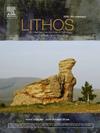藏南雅鲁藏布江缝合带西部中新世N-MORB型和oib型辉绿岩岩脉:对印度板块撕裂和软流圈-岩石圈相互作用的认识
IF 2.5
2区 地球科学
Q2 GEOCHEMISTRY & GEOPHYSICS
引用次数: 0
摘要
藏南地区碰撞后岩浆岩分布广泛,其成因为研究岩石圈尺度的热结构和成分结构提供了重要信息。然而,导致碰撞后岩浆活动的深层地球动力学过程仍然不明确。在雅鲁藏布江缝合带西部的Dare地区发现了中新世(约16 Ma)辉绿岩岩脉。大理岩辉绿岩可分为亚碱性系列和碱性系列。亚碱性辉绿岩表现为正常的海中脊玄武岩(MORB)型多元素分布模式,具有较高的正εNd(t)值(+8.23 ~ +8.99),较低的初始87Sr/86Sr(0.7059 ~ 0.7074)、LaN/YbN(0.50 ~ 0.72)和Y/Yb(8.94 ~ 9.91)。碱性辉绿岩呈现洋岛玄武岩(OIB)型多元素分布模式,εNd(t)低(+1.17 ~ +1.30),初始87Sr/86Sr (0.7064 ~ 0.7067), LaN/YbN高(16.57 ~ 20.45),Y/Yb高(12.69 ~ 13.44)。相对贫化的Sr-Nd同位素组成和不同的稀土元素比值表明,亚碱性辉绿岩和碱性辉绿岩最可能分别来自软流圈地幔源(尖晶石稳定场深度55 ~ 63 km)和含尖晶石石榴石稳定场深度85 ~ 91 km)。Sr-Nd同位素模型以及微量元素比值(Nb/Ta、Nb/U和Ba/Nb)进一步表明,这些软流圈衍生的熔体在上升和侵位过程中不同程度地受到上覆中坝岩石圈地幔和地壳的污染,这意味着软流圈-岩石圈之间存在明显的相互作用和由此产生的热扰动。从碰撞后岩浆岩的时空分布来看,俯冲印度板块的双侧撕裂最能解释73 ~ 89°E段东向年轻化、90 ~ 96°E段西向年轻化的东西向分带分布格局。此外,衍生的纵向撕裂和随后的板块推进将导致局部碰撞后岩浆岩分别向南和向北年轻化。本文章由计算机程序翻译,如有差异,请以英文原文为准。

Miocene N-MORB- and OIB-type diabase dikes in the western Yarlung Tsangpo suture zone, southern Tibet: Insights into the Indian slab tearing and asthenosphere–lithosphere interaction
Post-collisional magmatic rocks are widely distributed in southern Tibet, and their petrogenesis can provide critical information about lithospheric-scale thermal and compositional structures. However, the deep geodynamic processes responsible for post-collisional magmatism remain ambiguous. Here, Miocene (ca. 16 Ma) diabase dikes are identified in the Dare area within the western Yarlung-Tsangpo Suture Zone (YTSZ). The Dare diabase rocks can be divided into subalkaline and alkaline series. The subalkaline diabase rocks exhibit normal mid-ocean ridge basalt (MORB)-type multi-element distribution patterns and have high positive εNd(t) values (+8.23 to +8.99) and low initial 87Sr/86Sr (0.7059–0.7074), LaN/YbN (0.50–0.72), and Y/Yb (8.94–9.91) values. By contrast, the alkaline diabase rocks display oceanic island basalt (OIB)-type multi-element distribution patterns, and have low positive εNd(t) (+1.17 to +1.30) and initial 87Sr/86Sr (0.7064–0.7067) values and high LaN/YbN (16.57–20.45) and Y/Yb (12.69–13.44) values. The relatively depleted Sr-Nd isotope compositions and different rare earth element ratios reveal that the subalkaline and alkaline diabase rocks were most likely derived from asthenospheric mantle sources at depths of 55–63 km in the spinel-stability field and at depths of 85–91 km in the spinel-bearing garnet-stability field, respectively. The Sr-Nd isotope models, as well as several trace element ratios (e.g., Nb/Ta, Nb/U, and Ba/Nb), further demonstrate that these asthenosphere-derived melts were contaminated to varying degrees by the overlying Zhongba lithospheric mantle and crust during their ascent and emplacement, implying significant asthenosphere–lithosphere interaction and resultant thermal perturbation beneath the western YTSZ. Based on the spatiotemporal distribution of the post-collisional magmatic rocks, the bilateral tearing of the subducted Indian slab can best account for the E–W-trending zonal distribution patterns with an eastward younging trend in the 73–89°E segment and a westward younging trend in the 90–96°E segment. In addition, the derivative longitudinal tearing and subsequent slab advancement would lead to the locally southward and northward younging trends of post-collisional magmatic rocks, respectively.
求助全文
通过发布文献求助,成功后即可免费获取论文全文。
去求助
来源期刊

Lithos
地学-地球化学与地球物理
CiteScore
6.80
自引率
11.40%
发文量
286
审稿时长
3.5 months
期刊介绍:
Lithos publishes original research papers on the petrology, geochemistry and petrogenesis of igneous and metamorphic rocks. Papers on mineralogy/mineral physics related to petrology and petrogenetic problems are also welcomed.
 求助内容:
求助内容: 应助结果提醒方式:
应助结果提醒方式:


